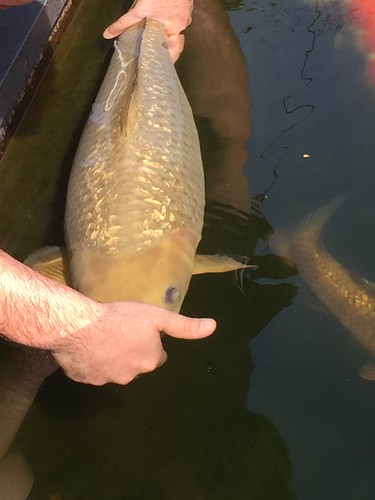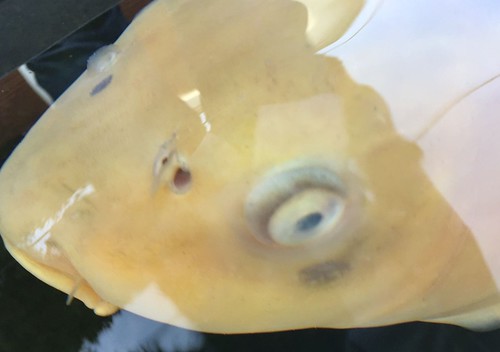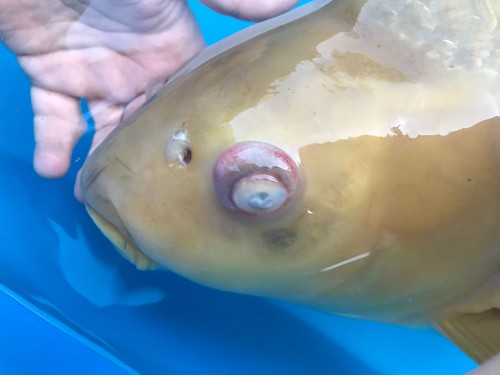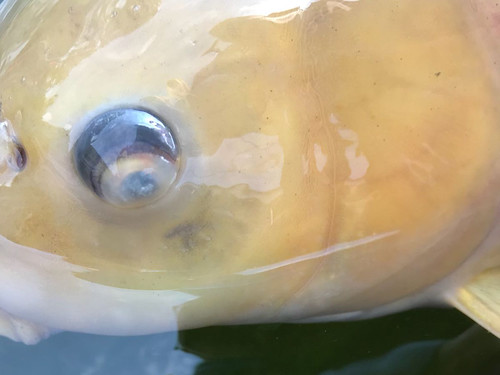Consultant Marco visits hobbyist
It is April, the start of the Koi season. The hoods go off the pond again, the filter is flushed and the sunshine comes through. Any fish purchased can be collected from the Koi dealers. Despite being told at many courses that new acquisitions should first spend time in quarantine before being added to the existing koi stock, in practice this is often skipped. Don’t get me wrong, I get that too. A second full-fledged pond with filter in a shed is just a bridge too far for some hobbyists (or some partners?). It can save you a lot of misery though, and should any misery arise, it is only in the quarantine tank. However, as I mentioned, in practice it turns out that many Koi go straight into the pond.

A consultant from the Advisory Group visits the pond
As a result, the release of new Koi in spring can then be accompanied by parasite outbreaks. Koi that get itchy from pesky critters as a result will scour, or jump in the hope of landing in a better environment. Or out of dissatisfaction, they lie down on the bottom with pinched fins. The spring mail server at the Advisory Group then runs overtime and René, our coordinator, distributes requests across the country to the advisers.
On 11 April, Ron contacted the Advisory Group. He does have a check every year to make sure everything is OK, but this time he is also a bit worried. There are two Koi lying on the bottom with pinched fins and one Koi hanging a bit. They also sometimes jump and shed. This sounds like aberrant behaviour to me and the same evening I am in his driveway, armed with microscope, water test kit and any other knickknacks I deem necessary to analyse the problems. Incidentally, another customer recently asked if I was coming to stay. Apparently I really have a lot of material at…..

Parasite found
I start by measuring the water values. The test case opens and I start mixing the drops from various vials into the cuvettes that I pre-fill with pond water. I can now do that almost blindly and without instructions, or routine.
I measure ammonia, nitrite, nitrate to check the nitrogen cycle in the biological part in the filter. In addition, measure pH and KH for pond acidification. As a consultant, I also always measure the KH from the tap to compare it with the KH from the pond and to say something about the refreshment rate. This time, I’ll skip that one. Ron and I live together in the neighbourhood. We both know that the KH from our water supply is 6. I check this once every two months.
In the meantime, Ron tells us that he recently added two Koi and has been tinkering in his filter. It has a drum filter, which keeps the pond nice and clean. However, last year, a little nitrite always remained present and so he wants to do some experimentation and see if there is a difference between various filter materials for in a moving bed. He also affected the flow of water in the moving bed to see if this makes a difference. I therefore find this interesting to keep following. If all goes well, the water is now better mixed in the moving bed.

All measured water values are not bad. The nitrite level is 0.025 mg/l, which I would prefer to see a little lower, but this is explained by Ron’s story. A combination of starting up new filter material, new stocking of Koi, rising temperature and starting feeding again and so on. The KH of his pond is 5. This is one point lower than from the tap, making it nothing shocking. As consultants, we sometimes see that because of little to no maintenance in winter, the KH of the pond and tap water differ greatly. A pH-crash then lurks. Ron is aware of this and therefore refreshes in winter and also tests his pond water himself. Otherwise, it is notable that the pond is already 14.8 degrees Celsius. Indeed, the pond is right in the sun. In the sunshine, the Koi are already happy to come begging for food and are already getting some all the time. Because yes, a wandering Koi is difficult to ignore.
Then making swabs. In total, we bowl three Koi together and I take six smears. Bingo! Unfortunately, I immediately find parasites called Trichodina. Whereas on the first four smears there were always a dozen or so, on a Yamabuki I find more than a hundred on a smear. Also, I find two skinworms, but we ignore them for now.

Treatment
And now? Is then the follow-up question. I think that with such amounts of Trichodina as there were on that smear combined with the abnormal behaviour, you need to treat and advise Ron to go to his Koi dealer to get pesticides. I discuss with him that he is likely to be presented with a choice between toxicants or oxidising agents, FMC or potassium permanganate. Ron comes home with Fish Pharma Calin (potassium permanganate) and will start treating the next day. We keep in touch via Whatsapp and after four hours, he breaks off treatment with NPC. A little Chagoi had a hard time during the treatment.
The day after the treatment the Koi are still having a hard time and I go back for a check-up. Would there still be parasites on it then? The treatment may then need to be repeated. Once again, I make several swabs and the Koi are all clean. No parasite could be found on all the smears. The treatment was successful. Rest and fresh water should do the trick is my advice. Ron happily notices a difference over the next few days and the fish start to perk up from the surely violent pesticides.

Eye infection
We are now five days on and, unfortunately, there is a new problem. The large Ginrin Chagoi suddenly has a thick eye. The swelling goes very fast. Within hours, it swells into a huge thick eye. I tell Ron that unfortunately I cannot help with this. I know bulging eyes from abdominal dropsy and at least this is not that. I recommend checking with a Koi doctor. Ron gets in touch and it is suspected that this Chagoi has bumped itself. Also, the Chagoi has a scratch on its nose. The Koidokter recommends a special eye ointment which should be smeared on the eye every day. Besides the many bad luck, Ron then has a little bit of luck that he lives a stone’s throw from me and that I am very keen to know how the thick eye heals and the possible positive effect of the eye ointment. I immediately realise that I am going to learn something from this myself. In other words, every day, in between soup and potatoes, I go and have a look and help bowl this Big Friendly Giant, so that Ron can rub ointment on the eye afterwards.

After just one day, we can already see that the swelling has gone down a tiny bit. Which is just as well, because any more swelling could not, in our opinion. This small improvement soon makes Ron (and me too) hopeful. Over the next few days too, we see that the swelling keeps decreasing. In the photos taken, the eye is much brighter than it appeared in real life. We could not see the pupil. The layer over it was always grey and opaque. Eye clarity increases every day.







After five lubrications, six days later, the eye looks so much better that Ron chooses not to bowl the Chagoi for a while, but leave it alone. The activity of the eye, the movement of the pupil, also increases. What we feared a few days ago, namely that the fish would go blind, that feeling is now completely gone.


The last picture was taken 11 days after the eye became swollen. The confirmation of the beautiful result.
I hope all the problems are over for Ron now. Now enjoy the summer and may many beautiful moments be spent at the pond’s edge with some grains of feed in hand. The Chagoi, like a cockerel at the front, will surely come to beg…..
This article has also been published in KoiWijzer and was provided by the Koi and Pond Advisory Group.
Text: Marco Zegers
Photos: Marco Zegers



